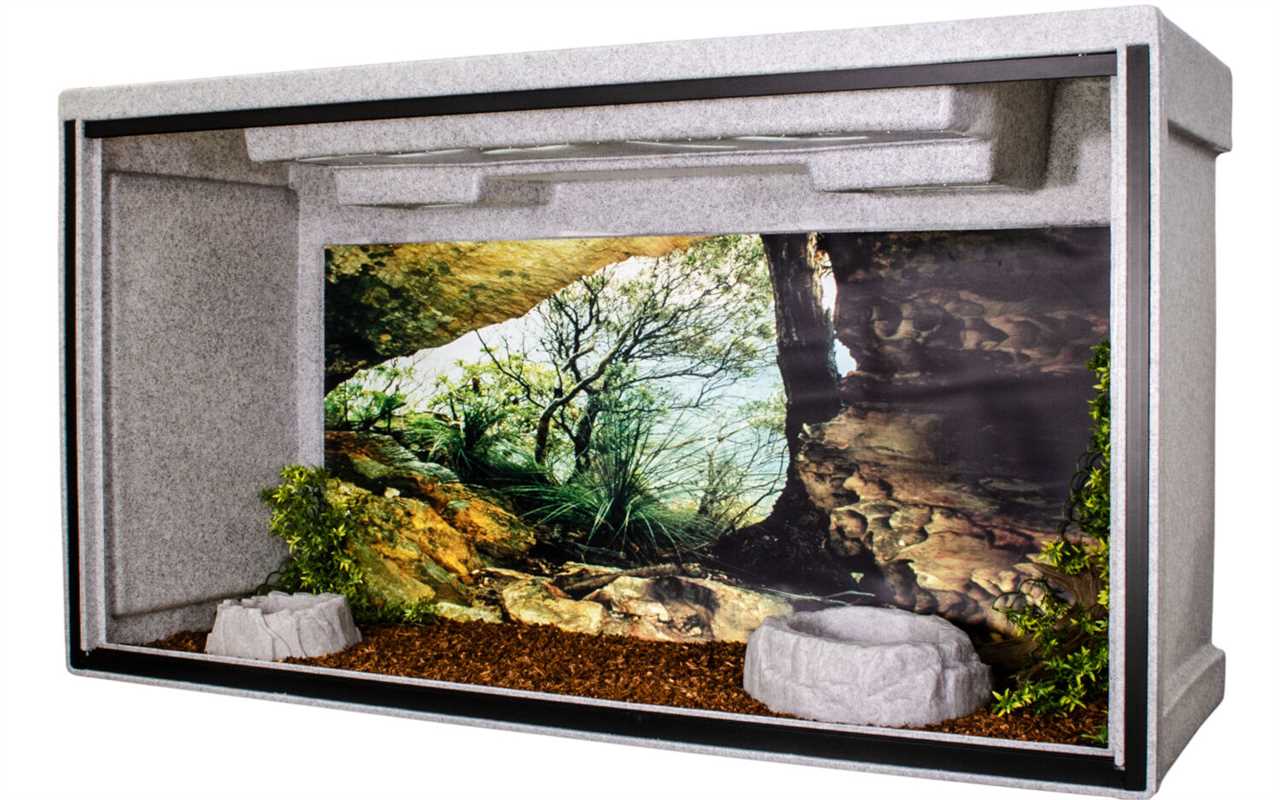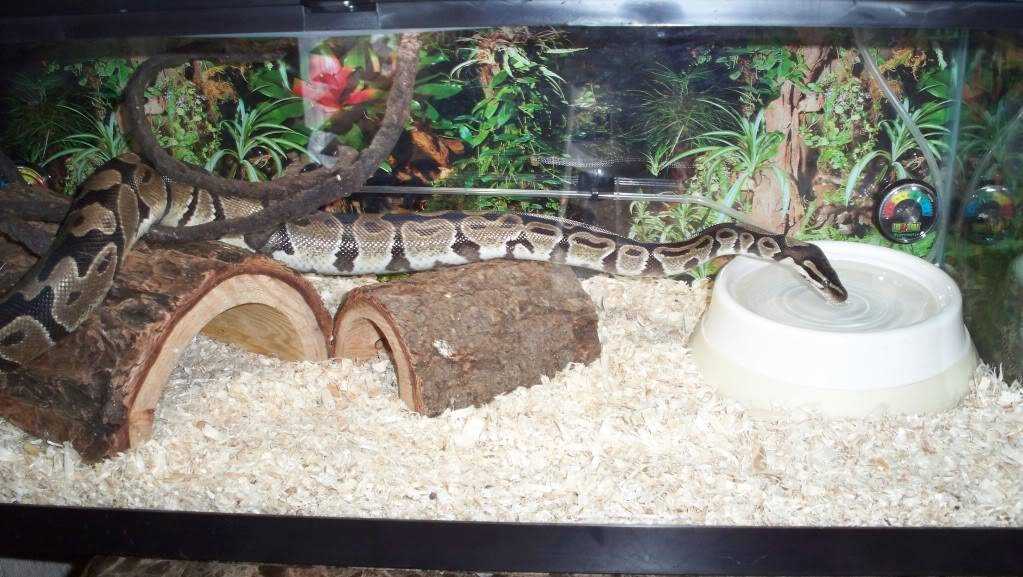
There are various types of enclosures available for ball pythons, including glass tanks, PVC cages, and wooden vivariums. Each has its pros and cons, but ultimately, the enclosure should be secure, well-ventilated, and easy to clean. It is also important to consider the size of the enclosure, as ball pythons need enough space to stretch out and move around.
The Importance of a Proper Ball Python Enclosure

A well-designed enclosure not only keeps your snake safe and secure but also ensures they can thrive and live a healthy life. Here are some reasons why having a proper ball python enclosure is so important:
1. Security: A proper enclosure provides a secure and controlled environment for your ball python. It should have a secure lid to prevent escapes and should be escape-proof, keeping your snake safe from potential predators or accidents.
2. Size: Ball pythons require enough space to move around and stretch out comfortably. An enclosure that is too small can cause stress and health issues for your snake. It is essential to provide an enclosure that is appropriately sized for their needs.
3. Temperature and Humidity: A proper enclosure allows you to control and maintain the temperature and humidity levels. Ball pythons require specific temperature and humidity ranges to stay healthy. A well-designed enclosure provides a thermal gradient, allowing your snake to regulate its body temperature, and ensures proper humidity levels are maintained.
5. Hides and Enrichment: Ball pythons are shy creatures and require hiding spots to feel secure. The enclosure should have multiple hides or shelters where your snake can retreat and feel safe. Adding natural decorations or enrichment items, such as branches or artificial plants, can also provide mental stimulation for your snake.
6. Lighting: While ball pythons are predominantly nocturnal, providing a day-night cycle with appropriate lighting can help regulate their biological clock and promote natural behaviors. UVB lighting is not necessary for ball pythons but can be beneficial for those housed indoors without access to natural sunlight.
7. Cleaning and Maintenance: A proper enclosure should be easy to clean and maintain. Regular cleaning helps prevent the buildup of bacteria and ensures a healthy living environment for your ball python.
Overall, investing time and effort into creating a proper ball python enclosure is crucial for the health and well-being of your snake. By providing a secure, comfortable, and stimulating habitat, you can ensure your ball python thrives and lives a long, happy life.
The Importance of Size for Ball Python Enclosures
Providing an appropriately sized enclosure for your ball python not only ensures the snake’s comfort but also contributes to its overall well-being. In a larger enclosure, the snake has more room to exercise and move around, which helps prevent obesity and promotes good physical health. It also allows for the creation of a more naturalistic environment, where the snake can exhibit its natural behaviors.
The Importance of Proper Temperature and Humidity in a Ball Python Enclosure
Temperature:
Humidity:
Humidity is another critical aspect of a ball python’s habitat. In the wild, ball pythons live in humid environments, so replicating this level of humidity is important for their health and shedding process. The ideal humidity range for a ball python enclosure is between 50% and 60%.
To maintain the proper humidity level, you can use a hygrometer to monitor the humidity inside the enclosure. You can also use a substrate that retains moisture, such as cypress mulch or sphagnum moss, and provide a water dish to help increase humidity levels. Mist the enclosure as needed to ensure that the humidity remains within the appropriate range.
Monitoring and Adjusting:
Make sure to check the temperature and humidity levels daily using a reliable thermometer and hygrometer. If necessary, make adjustments by increasing or decreasing the heat source or adding additional humidity sources to maintain the proper conditions.
By providing a habitat with the correct temperature and humidity levels, you are creating an environment that closely mimics their natural habitat and ensures the well-being of your ball python.
Choosing the Right Substrate for Your Ball Python’s Enclosure
Types of Substrate for Ball Python Enclosures
- Newspaper: This is the most basic and affordable option. It is simple to clean and provides a clean, odor-free environment. However, it doesn’t offer much in terms of environmental enrichment or natural aesthetics.
- Paper Towels: Similar to newspaper substrate, paper towels are easy to clean and maintain. They also provide a clean appearance, but lack any natural visual appeal.
- Aspen Bedding: Made from shredded aspen wood, this substrate is a popular choice among ball python owners. It is natural-looking, affordable, and has good moisture-absorbing qualities. However, it may need frequent changing to keep odors at bay.
- Cypress Mulch: This substrate is suitable for creating a more naturalistic and visually appealing habitat. It retains moisture well and helps create a humid environment. However, it should be avoided if your ball python has a habit of ingesting substrate, as it can cause digestive issues.
Considerations when Choosing Substrate
When selecting a substrate for your ball python’s enclosure, there are a few factors to keep in mind:
- Moisture Requirements: Ensure that the substrate you choose can help maintain the proper humidity levels for your ball python’s health.
- Ingestion Risk: Consider whether your ball python has a tendency to ingest substrate. If so, opt for a substrate that is safe for ingestion.
- Ease of Cleaning: Choose a substrate that is easy to clean and replace to ensure a hygienic environment for your snake.
- Visual Appeal: If aesthetics are important to you, consider substrates that provide a natural look and enhance the overall appearance of the enclosure.
Ultimately, the choice of substrate for your ball python’s enclosure will depend on your preferences and the specific needs of your snake. It is crucial to research and consider the pros and cons of each option to ensure you provide the best possible environment for your beloved reptile.
The Importance of Hides and Enrichment in Ball Python Enclosures
When creating a habitat for your ball python, it is essential to consider the importance of providing appropriate hides and enrichment. These elements not only enhance the overall aesthetic appeal of the terrarium, but they also play a crucial role in promoting the physical and mental well-being of your snake.
Hides
Hides are an essential component of a ball python’s enclosure. These small, enclosed spaces mimic the natural hiding spots that ball pythons seek out in the wild. By providing multiple hides throughout the vivarium, you are allowing your snake to feel secure and comfortable in their environment.
Enrichment
Enrichment refers to the addition of stimuli that encourage natural behaviors and mental stimulation in reptiles. While ball pythons may not be as active as some other reptiles, they still benefit from enrichment activities and objects within their enclosure.
Consider adding simple items like branches, leaf litter, or artificial plants to create a more engaging environment for your ball python. These elements can provide climbing opportunities, hiding spots, and sensory enrichment. Just ensure that any items you introduce are safe, non-toxic, and easily cleaned.
| Benefits of Providing Hides and Enrichment |
|---|
| 1. Reduce stress and anxiety |
| 2. Promote natural behaviors |
| 3. Increase physical and mental stimulation |
| 4. Enhance overall well-being |
The Importance of Proper Lighting in Ball Python Enclosures

1. Mimicking Natural Sunlight
2. Promoting Healthy Bone Development
Proper lighting, specifically UVB rays, is essential for the healthy development of a ball python’s bones. Without adequate UVB exposure, snakes may develop metabolic bone disease (MBD), which can lead to weak and brittle bones, deformities, and even death. By providing your snake with UVB lighting, you can greatly reduce the risk of MBD and promote strong bone growth.
3. Maintaining Circadian Rhythm
4. Enhancing Visual Perception
Proper lighting also enhances a ball python’s visual perception. Bright, well-lit enclosures allow snakes to see their surroundings more clearly, which can reduce stress and anxiety. It also helps them efficiently locate their food, water, and hiding spots, making them feel more secure in their environment.
Cleaning and Maintenance
Proper cleaning and maintenance of your ball python’s enclosure is essential for their health and well-being. Regular cleaning helps prevent the build-up of bacteria, mold, and odor, ensuring a clean and healthy habitat for your pet.
Here are some tips for cleaning and maintaining your ball python’s enclosure:
1. Regular Spot-cleaning:
Spot-cleaning involves removing any waste or soiled substrate as soon as it is noticed. Use disposable gloves and a scooper or tongs to safely remove any feces, shed skin, or uneaten food items. This will help prevent the growth of harmful bacteria and keep the enclosure clean.
2. Deep Cleaning:
Deep cleaning should be done periodically, typically every 4-6 weeks. This involves removing your ball python from the enclosure and temporarily placing them in a secure holding container. Remove all items from the enclosure, including hides, decorations, and substrate. Wash these items thoroughly in hot water with a reptile-safe disinfectant, ensuring all visible dirt and debris are removed. Rinse well and allow the items to dry completely before placing them back in the enclosure.
3. Disinfecting the Enclosure:
4. Preventing Odor:
By following these cleaning and maintenance practices, you can ensure a clean and healthy habitat for your ball python. Regular cleaning not only promotes your snake’s well-being but also allows you to monitor their health and detect any potential issues early on.
Remember to always wash your hands thoroughly before and after handling your snake or cleaning their enclosure to prevent the spread of any harmful bacteria.

I’m Lena Adams—a product of an unconventional upbringing in the African wilderness. My father, a daring explorer of African wildlife, sparked my fascination with reptiles, a passion that intertwined with the tragic loss of my mother during an expedition, leaving an indelible mark on my life. Driven to understand the creatures that captivated my parents, I embarked on my journey, sharing insights about reptiles, frogs, and lizards on my website. Through my explorations and conservation efforts, I honour my family’s legacy while seeking connections—to the creatures, nature, and the mother whose presence I yearn to understand.
